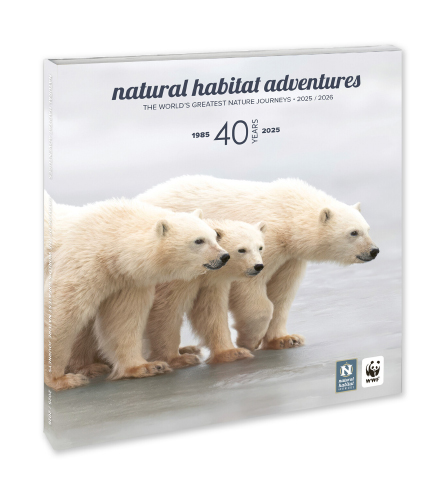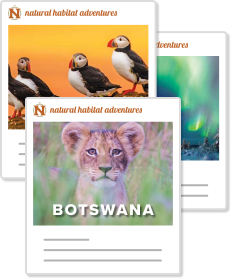In Nat Hab’s 10 Tips to Improve Your Wildlife & Nature Photography webinar, pro photographer and Expedition Leader Charlie Reinertsen shares his tips for capturing stellar shots of even the most fleeting animal encounters.
Here are some of Charlie’s tips for camera settings and composition techniques, photo gear and ways to improve your wildlife photography while enjoying your time in nature. Charlie’s always asking:
“How do I capture animals’ personalities? How do I make images that inspire people to conserve and protect them and their habitats?”
His photo tips provide a roadmap for photographers:

Nat Hab Expedition Leader Charlie Reinertsen using wildlife scope on our Mexico Monarch adventure.
1. Know Your Wildlife Ecology
Charlie’s first tip is to study up on the wildlife you hope to spot. He says:
“If you’re hoping to get photos of animals, you have to know them, know their habitats, and know their behaviors so you can set yourself up for the best possible position.”
Then, you match the time of year and your day to their behavior; follow their prey. Questions to ask include: When and where do they have young? Are there researchers or guides tracking the wildlife you’re hoping to photograph?
Understanding animal behavior is crucial for wildlife photography. Knowing when and where animals are most active, such as wolves and snow leopards being crepuscular (active at dawn and dusk), helps position you for the best shots.
Use local resources to determine what the animal will be doing at the time of year and day. For example, on wolf-watching photo expeditions in Yellowstone, knowledge of wolves’ seasonal behavior near dens helps photographers capture special moments.
Watching prey species like bison for signs of wolf presence also illustrates how understanding the ecosystem can guide your photography. The more you immerse yourself in the animals’ habits and environments, the better you’ll anticipate opportunities for extraordinary photos.

Botswana Safari © David Luck
Tips and Questions for Wildlife Photography Preparation:
- Does your camera perform well in the conditions (low light, for example)?
- Will you need a tripod to stabilize your camera?
- Telephoto Lens—fast lens, wide aperture; the longer the lens, the better
- Connect with the wildlife community online. Local trackers and experts can be fantastic resources.
General rules of thumb for a crisp image: Double the length of your lens compared to your shutterspeed. Cameras vary—test how high you can push your ISO without getting too much grain in the image. Some cameras will have much less noise.
Key takeaway: Use as many resources as you can to get information about where animals will be in the landscape and what they will be doing at particular times of the day and year.

Photographing coastal brown bears at Nat Hab’s Alaska Bear Camp © Brad Josephs
2. Use Depth of Field to Your Advantage
Sometimes, you’ll be pushed to the limits of what your camera can do in low light—the shutter will be as slow as it can go, the aperture will be as wide as it can be, and you may be as close to the animal as you can get safely without disturbing him or her. You’ll have limited variables to adjust.
Other times, you’ll have the opportunity to play with what and how much is in focus. The question to ask then is: What story do you want to tell? The answer can shape your decisions about depth of field.
Sometimes, a single leaf tells a fascinating scientific, cultural or conservation story. Then you can use a wide open aperture and shallow depth of field, so very few elements in your photo are in focus, just the leaf itself.
Why would you want that? To tell a detailed or small-scale story, like the story of photosynthesis through a furry leaf in an arid climate.

Nat Hab Expedition Leader © Nat Hab Staff Dana Cama
On the other hand, with an aperture of f9 (tiny), for example, a lot will be in focus. Use depth of field as one of the tools in your kit, just like you would a piece of gear. Charlie encourages:
“Always be thinking: Do I want really shallow depth of field, or do I want everything in focus? Stretch your thinking on how you’re using that tool.”
Manipulating the depth of field allows for creative expression and focus on your subject. Shallow depth of field emphasizes a singular subject, blurring out distractions, as seen in a macro shot of a leaf where the camera focuses solely on the leaf’s texture. Alternatively, a deeper depth of field keeps an entire landscape in focus. Knowing when to employ each method can transform your photography.
How near or far you are to your subject also shapes this decision. If you are close to the subject, the background will go out of focus with a wide-open aperture.
Try this depth-of-field photo tip: Learn about your camera’s depth of field by finding a leaf you’d like to photograph. Keep all the settings the same as you move further and closer away from your subject. You might find you like the soft background, bokeh, that comes from a blurred background, or you might prefer more detail in the background.

Photographing snow leopards © Ralph Lee Hopkins
3. Know When to Use and Ditch the Tripod
Reinertsen confesses to a constant conundrum: Should I bring it, or should I leave it when it comes to gear? With regard to his tripod, he says:
“I often leave it behind; the moment can be so fast, the tripod’s just in the way. Using the landscape—a rock, tree, or laying on the ground—can be helpful.”
When are tripods really useful, and when are they too heavy or cumbersome to carry in the backcountry? When can you get away without one? Here’s how Reinertsen explains:
Tripods stabilize shots in low light or long exposures, but they can be cumbersome in fast-moving situations. In most wildlife scenarios, a tripod can be a hindrance. Instead, he uses natural props, like leaning against a tree or lying down, to steady the camera.
“Sometimes you have to grab your camera really quickly and lay down—there’s no time for a tripod—even if it’s with you. You have to be ready to adjust your settings for the conditions, and that may be all you have time for.”
When do tripods help? A tripod is indispensable when you have time. For example, when you find something like an active nest and have time to set up and shoot for a while, you can also switch over to video.
Night sky photography is another time when you’ll want a tripod. One of the things you can do if you bump up your ISO, you can take multiple exposures, stack them in post producton, and that helps remove the noise.

Nat Hab guest photographs the wildlife of Brazil’s Pantanal © Expedition Leader Fernando Lessa
4. Bringing (and Leaving behind) the Right Gear
For wildlife and landscape photographers, bringing the right photo gear is a constant struggle. For Reinertsen, ease of movement is a priority. He says:
“I get burned out if I’m carrying everything all the time, so I plan my shots. Am I looking for large mammals moving across the landscape (300 mm) or small inquisitive birds who’ll come nearby if I have a couple of cranberries or peanuts (24 – 70 mm)?”
Charlie’s tip for deciding what camera gear to bring on your next trip is: Choose what you want to focus on. Decide your goal for the day or trip. Then cater your gear to your trip goals and shot list.
“My biggest advice for traveling is to plan to stitch images together in post-production to create a panoramic landscape image with a 50 mm.”
So, when faced with the question of what to bring, the question really is how to maximize the benefit of the gear you choose to bring.
Packing a lighter helps you remain nimble in the field while still being prepared to capture compelling images. This means not always lugging all your lenses but bringing the right one for the job.
Good to know, especially for longer Photo Expeditions: In our Q&A with Nat Hab Photo Expedition Director Mike Hillman, he shared that Nat Hab Photo Expeditions often have increased baggage allowances to help address this photo gear challenge.

Nat Hab Director of Photo Expeditions Mike Hillman at Alaska Bear Camp © Brad Josephs
5. Don’t Get Stuck on Your Usual (or even Favorite) Camera Settings
How do you break out of your habitual camera settings? Don’t get stuck in a rut. Try to maintain playfulness with your settings. Reinertsen confessed:
For the vast majority of my work, I:
- Set the camera to aperture priority
- Make sure the shutter isn’t too slow
- Protect the highlights (drop exposure down a couple of settings)
- Go into manual mode if needed.
The trouble with relying on the same settings or starting point is: you can get the same types of images over and over again.
Charlie’s advice? Challenge yourself to do things completely differently—even break the rules.

© Nat Hab Expedition Leader Jim Beissel
Use telephoto with wide open aperture and fast shutter speed for mountainous landscapes, for example, or something quite different from what you would normally do.
Switching up your aperture, ISO, or focal length challenges you to see and capture scenes differently, pushing your photography into new territory. Experimentation can unlock more creative shots.
Charlie’s tip: Play with settings and composition no matter how long you’ve been photographing nature and wildlife.
6. Share the Whole Story, Not Just the Hero Shot
The important point in Tip #6 is to tell the whole story. Sometimes luck and time in the field lead to the perfect shot, but there are a lot of other shots to get to tell the whole story of that particular locale.
Wildlife photography isn’t just about getting the perfect close-up. Capturing the broader ecosystem—like landscape shots, habitat details, or animal behaviors—helps tell the complete story of an animal in a place. Instead of solely pursuing one “hero” shot, work toward telling a visual story that encapsulates the environment, behavior, and life of your subject.
Tip: Ask yourself — what’s unexpected about this outing? Follow your curiosity; sometimes, it might lead you in an unplanned direction. Very often, a series of images over time in a day or outing can tell a story; no single image could.

Nat Hab Expedition Leader Court Whelan photographing the nature of Iceland © Andrew Ackerman
7. Practice Makes Perfect
How can you modify one thing, or return to the same place over and over and get different results?
Returning to the same location repeatedly allows you to study the landscape and notice its nuance and changes across seasons.
Try capturing the same scene or subject in summer, fall, and late autumn to showcase seasonal transitions. Constant practice in familiar environments helps you master technical aspects of photography, from composition to light management. Over time, you’ll notice new elements to photograph and refine your approach, allowing for a deeper understanding—and storytelling—of your subject matter and more refined images.
Photography is not one and done. There are always new ways to capture a particular place to inspire conservation in these areas.

Darwin finch, Galapagos Islands © Nat Hab Guest Melodie Smith
8. Sometimes, Put the Camera Down
Sometimes, it’s best to just put the camera down. It’s important to step back and observe the landscape or wildlife without the camera to connect more deeply with the environment.
This often leads to new insights or compositions that you might have missed. Some moments are better appreciated through direct experience, which can, in turn, inspire more thoughtful photography.

Nat Hab Guest in Greenland © Expedition Leader Marlo Shaw
9. Every Edit Counts
Key things take photos from good to great. Post-production is a critical part of elevating a good photo to a great one.
Key Takeaway: Editing is an integral part of the photographic process. Paying attention to small adjustments, from straightening the horizon to fine-tuning the color balance, can make a difference in the quality of the final photograph.

Australia Safari © Matt Meyer
10. Learn from the Pros
Charlie recommends seeking out professional photographers specializing in the places, genres and types of photography you love because their work can inspire new ideas and perspectives. Ask:
“Who do you look up to? How can you learn from their best work? What is it about their work that you are really drawn to?”
Studying the work of accomplished photographers can provide new techniques and inspiration. Charlie suggests following professionals like Jaime Rojo, whose work with monarch butterflies offers a fresh perspective on capturing wildlife.
Analyzing how other photographers use light, composition, and settings can help you think differently about your own work. Whether through books, exhibitions, or online portfolios, learning from others can spark ideas for your next photographic adventure.
These ten tips from professional photographer and Nat Hab Expedition Leader Charlie Reinertsen provide a strong foundation for wildlife and nature photography, blending practical advice with the creative aspects of visual storytelling. Whether you’re capturing the intricate details of a leaf or the grandeur of a distant mountain range, these techniques and considerations can help you take great photos on your next trip or in service of conservation goals important to you.

© Nat Hab Expedition Leader Jim Beissel
Audience questions:
I’m pretty new to photography; how should I prepare before heading out on a Nat Hab trip?
Charlie recommends: Practice in your backyard. Use anything—leaves, your dog, squirrels. Find things that move and that are still. Practice at different times of day, in different kinds of light. Try out all your camera settings so you know how they work because the last thing you want to be doing is trying to figure out your camera when something really cool is happening on a trip.
Can I still get some good shots if all I have is my phone?
Charlie’s response: Absolutely! See if you might be interested in shooting in raw formats on your phone. Check out online tutorials for how to maximize the performance of your phone’s camera.

Nat Hab Guests photograph the monarch butterfly migration in Mexico © Nat Hab Expedition Leader Court Whelan



























